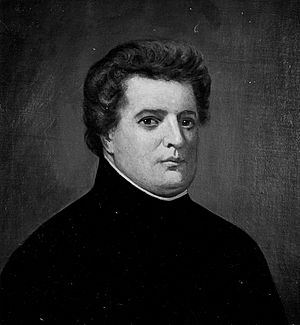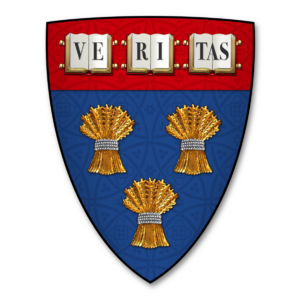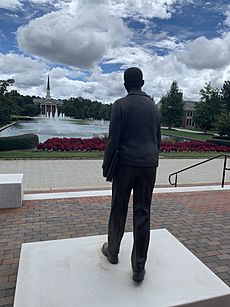Slavery at American colleges and universities facts for kids
The story of slavery at American colleges and universities is an important part of history. Many early colleges in the United States were built or funded with money and labor connected to slavery. Enslaved African people were forced to work, building dorms and classrooms. Even though we often think of slavery as a Southern issue, colleges in Northern states also benefited from it.
Wealthy slave owners sometimes gave large donations to new colleges. Some universities even sold enslaved people to get money. It was also common for rich students to bring an enslaved person with them to college. Even after slavery ended, its effects, like unfair treatment and unequal opportunities, continued to be a challenge at these schools.
In 2006, Brown University was the first university to share a detailed report about its connections to slavery. Since then, many other American colleges have started to research and teach about their own historical ties to slavery. In 2014, several schools, led by the University of Virginia, formed a group called Universities Studying Slavery (USS). This group helps colleges learn more about their past links to slavery and racism. After the 2020 George Floyd protests, there was a renewed call for universities to address their history with slavery and ongoing racism.
Contents
Brown University
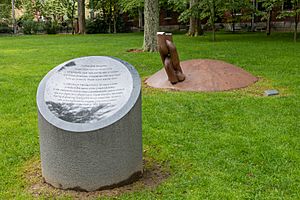
Some of the people who founded Brown University and its early leaders owned enslaved people. This included Stephen Hopkins, Brown's first leader, and James Manning, the college's first president.
The Brown Family
The Brown family, who the university is named after, were very important in starting and funding the college. They owned enslaved people and were involved in the slave trade, investing in two voyages that carried enslaved people in 1736 and 1759. However, compared to other wealthy families in Rhode Island, the Browns were not the biggest slave traders.
The family's views on slavery changed over time. In 1773, Moses Brown became a Quaker and decided that owning people was wrong. He freed his six enslaved people that same year. Moses then became a strong supporter of ending slavery. His brother, John, disagreed and continued to be involved in the international slave trade even after it became illegal in the 1790s. John was even the first person charged under the new law.
Brown's oldest building, University Hall, has many connections to slavery. A rich merchant and slave trader named Aaron Lopez gave wood for the building. The company of another slave trader, Nicholas Brown, Sr., led the construction. Many different people worked to build the hall, including enslaved people, free people of color, Native Americans, and white workers.
Slavery and Justice
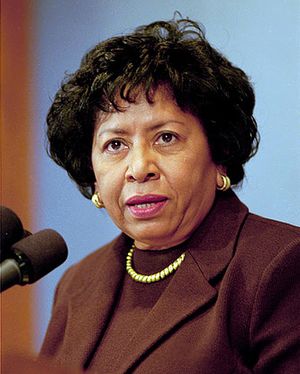
In 2003, Brown's president, Ruth Simmons, started a group to study the university's ties to slavery in the 1700s. In 2006, this group released a report called "Slavery and Justice." It showed how the university benefited from the transatlantic slave trade and the labor of enslaved people. The report also suggested seven ways the university could address this history.
Brown has since followed many of these suggestions. They created the Center for the Study of Slavery and Justice. They also gave $10 million to Providence Public Schools. Brown's report was the first big step by an American university to face its history with slavery. It encouraged other schools to do the same.
Memorialization
In 2014, Brown built a memorial to remember its connection to the slave trade. It also honors the African and African American people, both enslaved and free, who helped build the school. This memorial was one of the ideas from the 2006 "Slavery and Justice" report. The memorial, designed by artist Martin Puryear, looks like a huge ball and chain partly buried in the ground. It is located next to University Hall.
Reparations
In 2021, over 80% of students at Brown University voted for a non-binding idea. They wanted the university to pay reparations to the families of people enslaved by its founders. In April 2021, President Christina Paxson said that direct money payments to descendants was a "really complicated question."
Columbia University
Columbia University (then called King's College) was founded in 1754. By the end of the Civil War, at least half of its ten presidents had owned enslaved people. The first four treasurers of the school also owned enslaved people.
A report called Columbia University and Slavery lists the slave owners among its early presidents. These include Samuel Johnson, Benjamin Moore, William Samuel Johnson, William Alexander Duer, and Frederick A. P. Barnard. Duer's family became rich from the transatlantic slave trade. The university itself does not seem to have owned enslaved people directly. Since 2015, Columbia has kept a website with its findings about these connections.
Barnard College
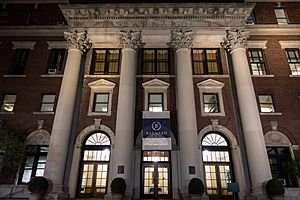
Barnard College is named after Frederick A. P. Barnard. He enslaved an unknown number of people. The women's college is partly named after him because he supported education for both women and men.
Barnard started enslaving people after he began working at the University of Alabama. Some of these enslaved people, like one named Sam, worked as research assistants in his labs. Others worked in his home. Other enslaved people linked to Barnard in Alabama included "Little Mary," Morgan, Luna, Tom, and Johnson. Barnard said his 16 years at the University of Alabama were "some of the happiest and most fruitful years of his life."
In 1859, a student attacked an enslaved woman named Jane who worked for Barnard at the University of Mississippi. Barnard was away at the time. He tried to get the student expelled. It is not clear if he wanted justice for Jane or if he was upset about the intrusion on his home and the loss of Jane's labor. Jane did not get justice because Mississippi law did not consider her testimony believable. The student was not expelled. This event caused problems between Barnard and the university, leading to his departure. He left much of his property, including his enslaved people, behind.
Barnard was not well-liked by his Southern colleagues, partly because he grew up in the North. Even though he owned enslaved people, his peers often thought he supported ending slavery. Barnard always said he supported the South and slavery. However, when he returned North during the Civil War, he wrote a letter to Abraham Lincoln. In it, he said he was loyal to the Union. He explained his past pro-slavery statements as a necessary political strategy. This explanation does not fully clear up the controversial issue of Barnard owning enslaved people.
Dartmouth College
Dartmouth College's founder, Eleazar Wheelock, enslaved at least 18 Black people during his life. Eight enslaved people went with Wheelock when he and his students started Dartmouth's Hanover campus in 1770. According to historian Craig Wilder, there were more enslaved people at Dartmouth than faculty, administrators, or active trustees. There were even as many enslaved Black people as there were students in the college course. Wheelock's enslaved people outnumbered his Native American students.
Dartmouth College president Nathan Lord defended slavery before the American Civil War. This caused a lot of disagreement and led to his resignation.
Georgetown University
1838 Jesuit Slave Sale
In 1838, the Maryland Province of the Society of Jesus, which ran Georgetown College, sold 272 enslaved people. About 10% of the money from this sale was used to pay Georgetown's debts. These enslaved people had lived on Jesuit plantations in Maryland. They were sold to Henry Johnson and Jesse Batey. The sale brought in $115,000. Of the first $25,000 payment, $17,000 was used to pay building debts that Thomas F. Mulledy, who arranged the sale, had made when he was Georgetown's president.
In 1821, Georgetown's business manager complained that the food given to the enslaved people on campus was too expensive. He said the slave rations were "carried there in abundance" and asked for cheaper food.
Hamilton College
Hamilton College had several alumni who supported ending slavery. It was also one of several New England colleges where groups against slavery formed in the 1830s. These groups were inspired by William Lloyd Garrison's American Anti-Slavery Society. The New York State Legislature threatened to stop funding the college, so the college's president, Joseph Penny, banned the group.
While the college's namesake, Alexander Hamilton, was involved in early efforts to free enslaved people, new evidence shows he also owned enslaved people and sometimes sold or leased them.
Harvard University
Enslaved people "served Harvard leaders." Their labor "played a vital role in the huge increase of wealth by New England merchants that created Harvard's foundation." Also, "Harvard students slept in beds and ate meals prepared by slaves." Many of these students grew up to be important slave owners and leaders in early America.
Presidential Initiative on Harvard and the Legacy of Slavery
In 2019, Harvard President Larry Bacow announced the Initiative on Harvard and the Legacy of Slavery. This effort aimed to understand Harvard’s historical ties to slavery and how those ties affect the university today. A committee was formed to research this history.
The committee's report came out in April 2022. It found that Harvard had strong connections to slavery. Harvard leaders and teachers enslaved more than 70 people in its early years. Many of these enslaved people served the college's first students. The report also showed that the university continued to benefit financially from slavery even after it was outlawed in Massachusetts in 1783. This happened through money from donors who got rich from the slave trade and from trading goods made by enslaved people.
The report also suggested ways for the university to address its legacy of slavery. These included supporting communities descended from enslaved people, remembering enslaved individuals, working with Historically Black Colleges and Universities (HBCUs), and finding and connecting with descendants.
President Bacow and Harvard's governing board agreed to these suggestions. They promised $100 million to carry them out.
Harvard Law School
Isaac Royall Jr. was a rich merchant who gave land and money to Harvard. He also funded the first law professorship. The Royall family was so involved in the slave trade that "the labor of slaves paid for the teaching of law in Cambridge." The Royall family's influence at Harvard lasted a long time. Harvard Law School used the family's crest as part of its own seal. This crest had a blue background with three bushels of wheat.
Many people did not know about this connection until recently. After it was revealed that Harvard Law had historical ties to slavery, Dean Martha L. Minow began telling new law students about the school's past. The law school stopped using the old seal in 2016. In 2019, they announced a group would design a new one. In 2021, the school showed a new seal with a design inspired by its buildings. In 2022, the Law School announced that the Royall Chair, a special teaching position funded by the Royall family, would be permanently retired.
In 2017, at the law school's 200th anniversary, President Drew Faust, Dean John Manning, and Professor Annette Gordon-Reed revealed a new plaque. It honors the enslaved people who helped build the schools. Faust said that the path to justice is not always easy. She encouraged everyone to look clearly at history to build a more fair future, honoring the lives of those who were enslaved.
2011 Report: Harvard and Slavery – Seeking a Forgotten History
In 2011, professor Sven Beckert, then student Katherine Stevens, and students from a Harvard seminar published a report. It was about Harvard University and its ties to slavery. They were inspired by Ruth Simmons' work at Brown University and started their research in 2007. The report explains Harvard's connections to slavery within the larger history of American slavery, Northern slavery, and the Triangular Trade. It notes that by the mid-1600s, enslaved people were a common part of daily life in colonial Massachusetts. They lived and worked in the colony. Their owners were often political leaders and heads of important families. However, unlike the Brown University report, this one did not make any official suggestions for action.
Johns Hopkins University
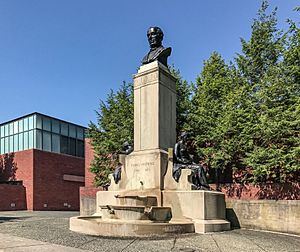
In 2020, historians at Johns Hopkins University found that its founder, Johns Hopkins, listed four men as his property in the 1850 census. Hopkins had also used enslaved people as a guarantee for debts.
Before this discovery, the university believed its founder was a "strong abolitionist," someone who wanted to end slavery. This belief came from a 1929 book written by his grandniece and published by the school. People also pointed to his instructions that his hospital should care for people of any race. He also encouraged the hospital's leaders to create an orphanage for Black children. This new information might have been unknown for so long because most of Hopkins' personal papers were lost after his death.
The university now says that "the current research... finds no evidence to support [the] description of Johns Hopkins as an abolitionist." In a letter, the university's president, Ronald J. Daniels, said the findings "complicate the understanding" of the school's founder.
University of Pennsylvania
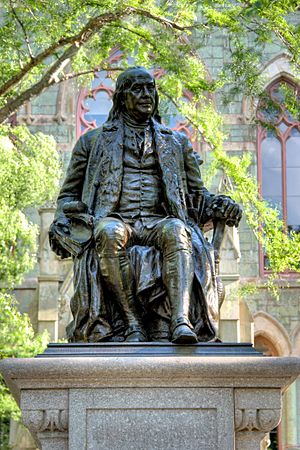
The University of Pennsylvania's founders, donors, trustees, and teachers included slave owners. Among them was the university's founder and first president, Benjamin Franklin. He also made money from and helped the slave trade by running advertisements for the sale of enslaved people in his newspaper, the Pennsylvania Gazette.
In 2017, the university started the Penn & Slavery Project. This project explores the connections of its funders, trustees, and teachers to slavery. It also aims to uncover the stories of people enslaved by them. Some of the university's trustees who enslaved people included John Cadwalader, Benjamin Chew, Benjamin Franklin, Isaac Norris, William Plumsted, James Potter, Joseph Reed, and Thomas Willing.
Caesar was an enslaved man who worked at the university from 1756 to 1770. He was enslaved by Ebenezer Kinnersley, a colleague of Benjamin Franklin and a faculty member. Caesar's jobs on the early university campus included ringing the school bell and making fires for the students. Kinnersley was paid by the university for Caesar's work. It is not clear if Caesar was ever freed. Caesar's Bell became a symbol for the Penn & Slavery Project. It had been in the Van Pelt Library without any mention of Caesar's work.
Princeton University
Sixteen of Princeton University's first twenty-three trustees "bought, sold, traded, or inherited slaves during their lifetimes." The school had "deep and close ties to human bondage." The first nine presidents of Princeton University enslaved people. When its fifth president, Samuel Finley, died in 1766, the people he held captive were sold at auction on campus. John Maclean Jr. (president from 1854-1868) was the first president who did not force people to work against their will. Princeton also had connections to the colonization movement. This movement aimed to stop the Atlantic Slave Trade but also wanted to send freed enslaved people back to Africa.
Even after slavery ended, unfair treatment and unequal opportunities continued at Princeton. For example, Princeton President Woodrow Wilson (1902-1910) held beliefs that favored white people over others.
Rutgers University
Rutgers University is named after Henry Rutgers, who was a trustee of the school. He was a third-generation slave owner. As a real estate developer, he used enslaved labor to build his own wealth.
Rutgers has a long history with the slave trade. Some of its founders, early donors, and early presidents were involved in it. During the Revolutionary War, the college moved to the home of a slave owner. The first president of Rutgers (then Queen's College), Jacob Rutsen Hardenbergh, was a slaveholder. Among his enslaved people was Sojourner Truth, who later escaped to freedom. Rutgers University's oldest existing building, Old Queens, was partly built by enslaved laborers, including a man named Will.
Before Rutgers University reached its 250th anniversary, Chancellor-Provost Richard Edwards announced a committee. This committee created the Scarlet and Black Project, which published three books and digital archives covering Rutgers' entire racial history.
The committee also made suggestions. These included openly acknowledging its history on campus, expanding programs that help diverse students, building a memorial for the dispossessed and enslaved, renaming buildings, funding more research, and making a diversity course required for all students.
University of Virginia
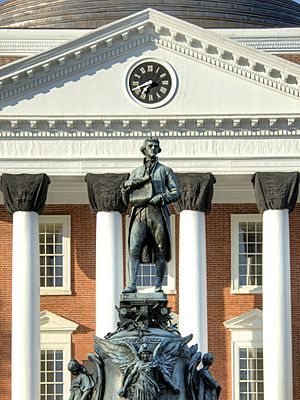
The University of Virginia in Charlottesville, Virginia owned and rented enslaved people for decades. Between 1817 and 1865, about 4,000 enslaved people worked on the University of Virginia's campus. All the men who founded the university were slave owners. These individuals took care of the university's grounds, built buildings, served the students and teachers, and sometimes lived in rooms below student residences. Most students during this time could attend because their families were wealthy from owning enslaved people. However, these students were not allowed to bring their own enslaved people.
After the Civil War, even though the enslaved people at the university gained their freedom, they were still employed for very low wages.
Thomas Jefferson
The University of Virginia's founder, Thomas Jefferson, enslaved more than 600 African American people during his lifetime. Most historians believe that after his wife Martha died, Jefferson had a long relationship with her half-sister, Sally Hemings, an enslaved woman on his plantation, Monticello. Based on DNA evidence from living descendants and family stories, Jefferson likely had at least six children with Hemings, with four surviving to adulthood.
When he created the University of Virginia, Jefferson wanted it to be a place that would protect against those who wanted to end slavery in the North. Jefferson's own enslaved people helped build the university.
Memorial to Enslaved Laborers
In 2020, the university finished building its Memorial to Enslaved Laborers. This memorial honors the community of enslaved African American workers who built and helped run the university.
College of William and Mary
The College of William & Mary benefited from enslaved labor from its beginning in 1693 until the Emancipation Proclamation made slavery illegal in 1863. An academic study into its slavery history, called the Lemon Project, is currently underway.
Between 1760 and 1765, the Prince George House might have been used by English charities to teach and educate local enslaved and free Black children. Adam and Fanny, two children enslaved by William & Mary, attended the school at its second location in Williamsburg.
Furman University
In 2016, a student newspaper article discussed the Furman family's history of slaveholding. It questioned a plaque on a building named after the university's first president, James C. Furman. In response, the university joined Universities Studying Slavery in 2017. They created a Task Force on Slavery and Justice. This group's report, "Seeking Abraham," came out a year later. It documented how the university's namesake, Richard Furman, led Baptist views on slavery. It also answered questions about James C. Furman.
The report's title refers to Abraham Sims, an enslaved person owned by the Furman family. The search for information on Abraham was like the report's wider goal of finding the whole history of Furman University. The report also showed how the university moved because it relied on money from slave owners. It also used enslaved labor to build its first campus in Greenville, South Carolina. The report also looked at the effects of slavery up to the present day. It focused on resistance to ending segregation at the university, the experiences of Black students facing racism, and limited African-American attendance throughout the 1900s.
In response, the Furman University Board of Trustees agreed the report was accurate. They promised to fix historical harms. This included a scholarship for African-American students, especially those from the college's historic locations. Trustees put up a plaque that renamed the building "Furman Hall" instead of "James C. Furman Hall." It also pointed out the racist arguments Furman used to support leaving the Union. An annual event, Joseph Vaughn Day, began in 2019. A central plaza on campus, Joseph Vaughn Plaza, was installed in 2020. Clark Murphy Residential Housing Complex became the first building on campus named for an African-American person. This person was enslaved by the Greenville Woman's College, which merged with Furman University in the 1930s. The university's mission statement was changed significantly in the same year. It now says, "As we learn from carefully looking at our university’s past, we support respect for all people and actively welcome ideas from many different backgrounds, cultures, and beliefs."
Yale University
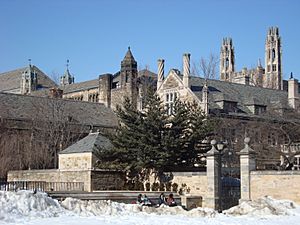
Yale University is named after Elihu Yale, a slave trader and merchant. According to historian Craig Steven Wilder, Yale also "inherited a small slave plantation in Rhode Island that it used to fund its first graduate programs and its first scholarships." The university "actively looked for ways to benefit from the slave economies of New England and the wider Atlantic world."
In 1998, the university created the Gilder Lehrman Center for the Study of Slavery, Resistance, and Abolition.
The history of slavery at Yale was discussed in the February 2002 edition of the Yale Alumni Magazine.
In 2017, after years of protests, Yale University renamed Calhoun College to Grace Hopper College. The college had been named after Vice President John C. Calhoun, a South Carolina slave owner and someone who was against ending slavery. Other buildings still have the names of slave owners, including Bishop George Berkeley, Timothy Dwight, and Ezra Stiles.


